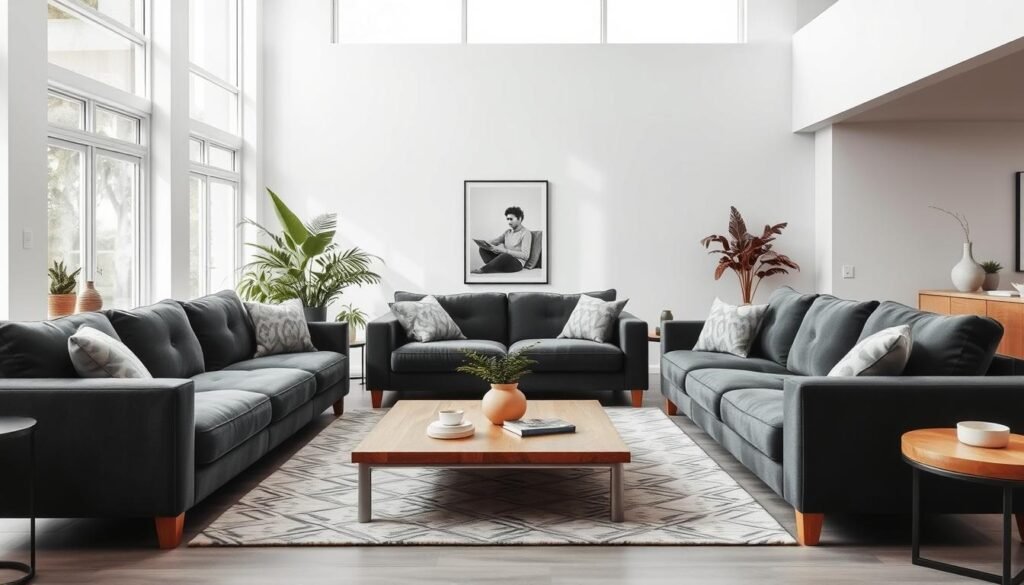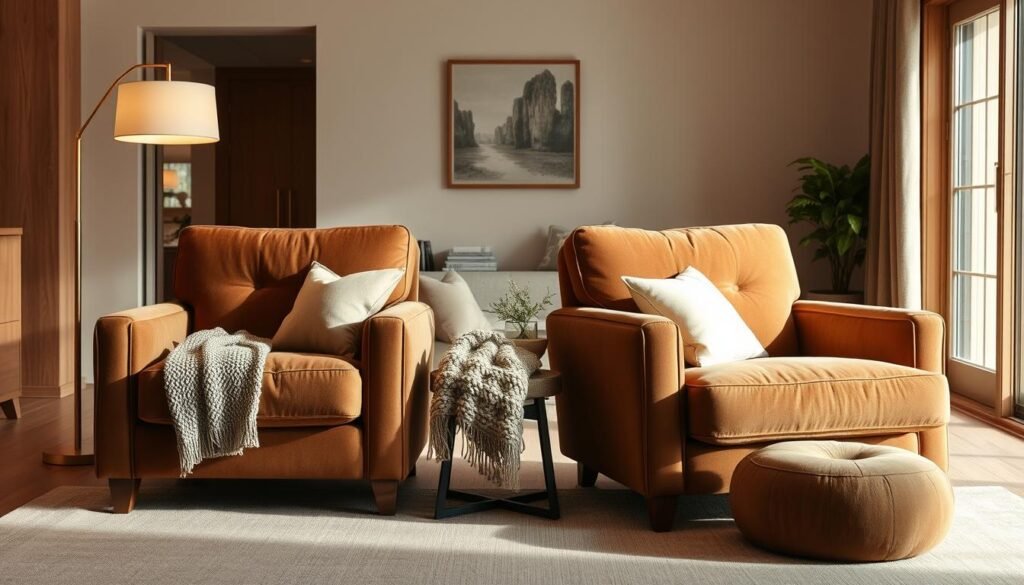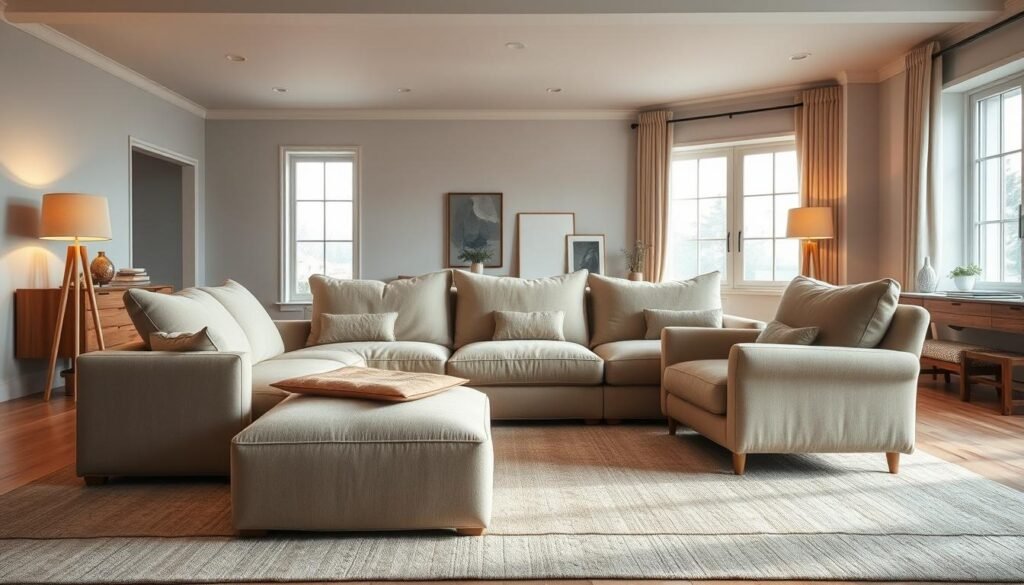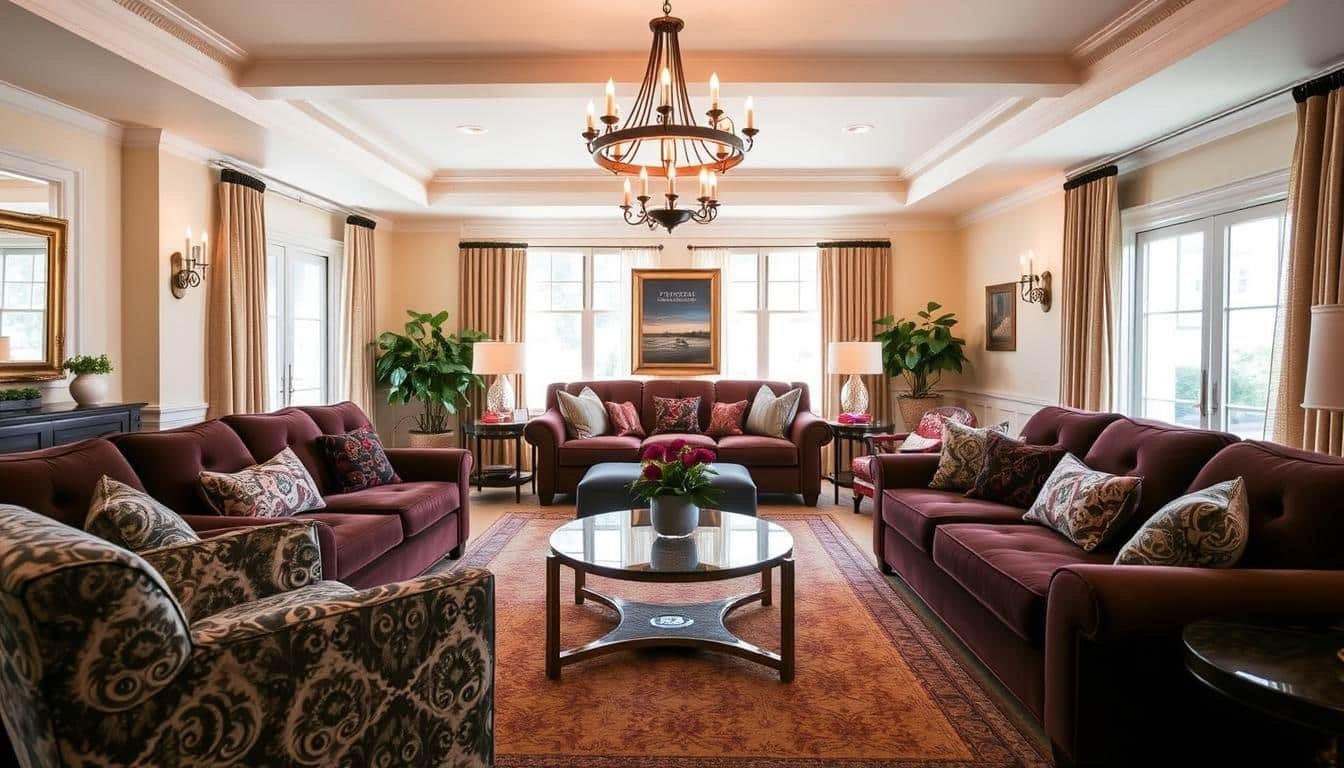This post may contain affiliate links. When you purchase through links on our site, we may earn an affiliate commission.
What if I told you that bold furniture choices could make your space feel more inviting without sacrificing visual appeal? After transforming dozens of homes, I’ve learned that creating a sanctuary starts with challenging one stubborn myth: that spacious seating means cluttered chaos.
My journey began with a cramped apartment and a love for hosting. Through trial and error, I discovered how strategic furniture placement turns even modest rooms into conversation-friendly zones. The secret? Balancing statement pieces that welcome you to sink in while keeping the layout airy.
Let me show you how to avoid the “showroom trap” – spaces that look perfect but feel stiff. We’ll explore how to mix textures, play with proportions, and choose pieces that grow with your lifestyle. Because your living area shouldn’t just impress guests – it should hug you after a long day.
Key Takeaways
- Spacious seating enhances both aesthetics and relaxation when balanced properly
- Strategic placement prevents bulky furniture from overwhelming rooms
- Layered textures add depth while maintaining functional comfort
- Neutral foundations allow easy seasonal style updates
- Multi-functional pieces maximize space in smaller homes
- Proper scale relationships create harmonious layouts
Introduction: Setting the Stage for a Relaxing Living Room
Every living room tells a different story. Mine began with a 500-square-foot apartment that had more angles than a geometry textbook. Those odd corners and slanted walls taught me a valuable lesson: your space should adapt to you, not the other way around.
My Personal Journey With Oversized Furniture
I’ll never forget shoving my third standard-sized chair against a protruding fireplace ledge. The room felt like a maze – all pathways, no breathing room. That’s when I discovered a truth: bigger isn’t always bulkier.
Switching to deeper seating transformed my cramped quarters. A generous sectional hugged the room’s quirks instead of fighting them. Strategic placement created natural walkways, proving even petite spaces can handle bold proportions when you work with the architecture.
Why Comfort Matters in Your Living Space
True relaxation isn’t about sinking into cushions – it’s about how a room invites connection. I once chose sleek chairs that looked magazine-ready but kept guests perched like nervous birds. Now, I balance plush seating with intentional negative space.
“Design should whisper ‘stay awhile,’ not shout ‘look but don’t touch,’” a mentor once told me. That philosophy guides every layout I create. When your living area feels like an embrace rather than a display case, you’ve nailed the comfort-style equation.
Understanding Oversized Furniture in the Modern Living Room
Remember that awkward dinner party where everyone clustered near the kitchen? That’s when I realized scale isn’t just a measurement – it’s a conversation starter. Modern homes demand intentional choices that shape how we live, not just how we look.

The impact of scale on living spaces
I once tried squeezing a standard loveseat into a narrow den. The result? A hallway masquerading as a seating area. When I swapped it for a deep-seated chair with slim arms, magic happened. The room breathed while keeping its cozy vibe.
| Room Size | Ideal Furniture Size | Pro Tip |
|---|---|---|
| Small (under 12x12ft) | 78″ sofa max | Use vertical space with tall lamps |
| Medium (12-18ft) | 90″ sectional | Angle chairs toward windows |
| Large (18+ ft) | 120″ curved sofa | Create zones with area rugs |
How statement pieces transform room dynamics
My client’s oversized living room felt like a airplane hangar until we added a massive modular sofa. Suddenly, the space had purpose. Guests naturally gravitated toward the plush corners, proving that bold furniture writes the room’s script.
Here’s what I’ve learned: A single well-chased chair can anchor an entire wall. Sectionals act like visual punctuation – they tell people where to pause and connect. When you get the proportions right, even empty corners feel deliberate rather than neglected.
How to Prioritize Comfort with Oversized Sofas and Accent Chairs
Hosting my first book club taught me a hard truth: even the most stylish chairs can leave guests shifting positions every five minutes. That experience shaped my approach to creating spaces where people want to linger.

Key Factors for Maximum Seating Comfort
Seat depth makes or breaks relaxation. I look for chairs with 22-24 inches from front to back – enough to curl up without dangling feet. Down-filled cushions might feel heavenly initially, but high-resiliency foam retains its shape better over time.
Test every piece like you’re auditioning it. Sit cross-legged. Lean back. Notice if armrests hit at the wrong spot. One client’s statement chair caused shoulder tension until we swapped its rigid frame for a softer design.
Integrating Design Tips From Industry Experts
Interior designer Mara Brent once told me: “Matching chairs are like identical twins – charming at first, but eventually predictable.” I follow her 2:1 ratio – pair similar chairs, then introduce a wildcard with contrasting fabric or legs.
- Velvet chair + leather ottoman
- Wood-framed seat beside metal side table
- Neutral sofa with patterned accent pieces
Small spaces thrive with standard-sized furniture that grounds the room. I recently used a classic wingback in a studio apartment – its familiar proportions made the space feel intentional rather than cramped. The secret? Let each piece breathe with 18-24 inches of walking space around it.
Choosing the Right Oversized Sofas and Accent Chairs for Your Home
A tape measure and floor plan became my best tools after a furniture fiasco left me crawling over armrests to reach the coffee table. The right chair transforms your room from functional to magnetic – but only if it fits like a glove.

Evaluating Room Dimensions and Layout Challenges
I once bought a leather sectional that blocked half the doorway. Now I measure twice: wall lengths, ceiling height, even radiator placements. Here’s my rulebook for different spaces:
| Room Size | Max Furniture Width | Smart Solution |
|---|---|---|
| 10×12 ft | 72″ sofa | Backless benches as dual seating/storage |
| 12×15 ft | 96″ sectional | Nesting tables save floor space |
| Open concept | 120″ modular | Use rugs to define zones |
Leave 30″ walkways between chairs and walls. For recliners, add 12″ behind. I sketch layouts with painter’s tape on the floor – it reveals traffic jams before delivery day.
Selecting Materials and Finishes That Enhance Comfort
That buttery-soft leather sample? It becomes a sticky furnace in summer. I test materials under lamps to see how they’ll look at night. Performance fabrics withstand spills, while linen breathes in humid climates.
Deep seats (22-24″) need firm cushions. Down-filled backs mold to your spine, but high-density foam seats keep their shape. For chairs near windows, I choose fade-resistant textiles – nothing worse than sun-bleached armrests by July.
Last tip: Rub fabric swatches against your forearm. If it snags a hangnail, imagine it catching sweater threads for years. Your home deserves materials that age like fine wine, not milk.
Creating a Cozy Layout: Tips for Arranging Your Living Space
Rearranging my cousin’s cluttered den revealed a universal truth: furniture placement can either spark connection or kill conversation. We rotated her sectional to face the bay window, instantly creating a sunlit gathering spot that transformed movie nights.
Designing Conversation Areas Around Focal Points
Natural gathering spots exist in every room. I map these zones by observing where people naturally pause. A statement chair angled toward the fireplace becomes an invitation, while twin loveseats facing each other foster face-to-face chats.
| Room Size | Layout Approach | Seating Types |
|---|---|---|
| Compact (under 300 sq ft) | Single focal point | Apartment-sized sofa + 2 chairs |
| Mid-sized (300-500 sq ft) | Dual zones | Sectional + accent chairs + ottomans |
| Spacious (500+ sq ft) | Multiple clusters | Conversation pits + reading nooks |
Balancing Seating and Open Space
Interior designer Lorna Gross once told me: “Empty floor is negative space that lets your eyes rest.” I leave 42″ between coffee tables and seating – enough room for legs to stretch without feeling distant.
In my studio apartment, a slim console behind the sofa serves as both storage and visual buffer. Floating chairs away from walls creates intimate pockets while maintaining flow. Test layouts by walking through imaginary scenarios – where would guests set drinks? How does light move across space during evening gatherings?
Mixing Textures and Materials for a Unique Style
My client’s all-beige living room taught me a vital lesson: monochromatic doesn’t have to mean monotonous. When we introduced a caramel leather sofa beside linen armchairs, the space gained depth without losing its calm aesthetic. This experiment became my blueprint for layered design.
Combining Leather, Fabrics, and Natural Finishes
I start every project by laying material swatches on the floor like puzzle pieces. A successful mix balances contrast and harmony. Try pairing a tufted leather sofa with chairs in nubby bouclé – the combination feels rich but approachable.
| Material | Best Pairings | Style Tip |
|---|---|---|
| Full-grain leather | Linen, wool | Add brass accents |
| Velvet | Oak finishes | Use in small doses |
| Reclaimed wood | Brushed nickel | Pair with matte textures |
Designer Elena Vazquez once told me: “A room should feel like collected treasures, not a furniture showroom.” I apply this by mixing eras – like placing midcentury chairs beside an Art Deco console. The secret? Keep materials consistent even when styles differ.
Lighting dramatically affects textures. Test swatches under your room’s actual bulbs. That gorgeous charcoal leather might look muddy under warm lighting. I keep samples for 48 hours, observing how morning sun and evening lamps change their appearance.
For high-traffic areas, I choose leather that develops patina over time. In a recent project, cognac chairs gained character from everyday use while maintaining their luxe feel. Remember: varied textures make spaces feel lived-in, not worn-out.
Balancing Focal Points and Conversation Areas
Designing my friend’s dual-purpose media lounge taught me that rooms often serve competing functions. The solution? Strategic placement that honors both visual anchors and human interaction. I discovered that furniture arrangement could make a space feel intentionally designed rather than accidentally crowded.
Chair Placement as Visual Wayfinding
Two chairs facing a sofa create instant dialogue zones without blocking views to other features. In a recent project, we positioned swivel chairs between a fireplace and television wall. Guests could pivot naturally between warmth and entertainment.
| Room Feature | Chair Solution | Side Table Tip |
|---|---|---|
| Bay window | Single armchair + ottoman | Use wall-mounted shelf |
| Corner nook | Pair of slipper chairs | Round pedestal table |
| Open concept | Floating chair group | Nesting tables between seats |
Furniture as Boundary Markers
I once used a leather wingback to subtly separate a dining area from a living space. Angled at 45 degrees, it created visual separation without physical barriers. The secret? Maintaining 18″ clearance between furniture groups for smooth traffic flow.
Side tables became my secret weapon after a client’s cramped layout. We replaced matching end tables with one sculptural piece between chairs. The result? A curated look with room for drinks and decor. Remember: furniture placement should solve puzzles, not create them.
The Role of Color and Accessories in Enhancing Comfort
Choosing paint swatches for my first client’s living room revealed more about color psychology than design school ever did. That project taught me hues don’t just decorate walls – they shape how we experience space.
Building a cohesive color palette
I start with three base tones: one dominant, two supporting. Earthy terracotta walls might pair with cream upholstery and walnut accents. For bold chairs, I let their fabric dictate the scheme. A navy velvet seat becomes the North Star, guiding accessory choices.
| Base Color | Texture Pairing | Accent Tip |
|---|---|---|
| Sage green | Brass hardware | Add rust-colored throws |
| Warm gray | Knitted wool | Introduce matte black frames |
| Deep navy | Brushed velvet | Use metallic gold pillows |
Selecting decor that complements oversized pieces
Large furniture needs breathing room. I balance a substantial chair with slim floor lamps and low-profile side tables. Designer Elena Vazquez once noted: “Accessories should whisper secrets, not shout announcements.”
In my studio project, charcoal linen chairs gained warmth through terracotta pots and woven baskets. The trick? Repeat colors vertically – matching throw pillows to artwork tones creates visual rhythm without clutter.
Lighting transforms color perception. I test paint samples at dawn and dusk. That perfect peach wall? It might glow like sunset at noon but turn muddy under evening lamps. Your home deserves colors that adapt to life’s rhythms.
Designing with Function and Style:
The final piece of my design puzzle clicked when a client’s toddler transformed their pristine white sectional into an abstract art project. That moment taught me true style isn’t fragile – it’s living through the messes and memories we create daily.
Great spaces serve dual purposes. I choose materials that patina beautifully, like leather that softens with use. Floating shelves near seating areas keep essentials handy without cluttering surfaces. Every decision asks: “Does this elevate daily life?”
Balance comes through contrast. Pair streamlined furniture with organic textures – think smooth marble tables beside nubby wool throws. Lighting becomes functional jewelry when sconces cast warm pools of light exactly where needed.
Your home should tell your story. Mine features a dented brass lamp from Paris beside IKEA staples. That mix of high and low creates spaces that feel collected, not calculated. Now go design rooms that work as hard as you play.

 using WordPress and
using WordPress and 
No responses yet